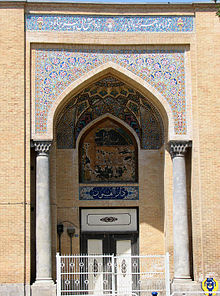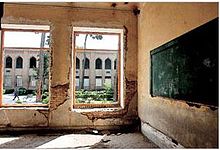Dar al-Fonun
Dar al-Fonun ( Arabic - Persian دار الفنون, DMG Dār al-Fonūn , 'place of scientific disciplines', also Dāro'l-Fonūn ) was the first polytechnic in Iran . Founded in 1851 by Naser ad-Din Shah's Prime Minister Amir Kabir in southern Tehran on Nasser Chosrow Avenue, the Dār al-Fonūn, also known as the "House of Science", was the first modern university in Iran. With the establishment of the dar ul-funun Iran had previously resolved the first time after the dissolution of the famous, higher academic institutions of more than 800 years, from I. Shapur 271 founded Academy of Gondishapur and Persian under the grand vizier Nizam al-Mulk established Nizamiyahs , again an academic teaching and research facility.
history
One of Amir Kabir's main concerns was to modernize Iran's economy in order to catch up with industrial development in Europe. Above all, academically trained engineers were required for this. In addition, Amir Kabir wanted to build an army in Iran that was powerful enough to protect the country from foreign invaders.
When planning Dār al-Fonūn, Amir Kabir was aware that he would have to recruit foreign teachers. He commissioned Mirza Dawud Khan, the first interpreter at the court of Naser al-Din Shah, with this task. Dawud (David) Khan was an Armenian born in Smyrna who, prior to his employment at the Persian court, had worked as an interpreter at the Austrian consulate in Smyrna and who had acquired Austrian citizenship in addition to his Persian citizenship . During a visit to Vienna he married a daughter of the Baron von Schlechta and therefore had excellent relations with the court in Vienna. Dawud Khan traveled to Vienna to recruit teachers for the Dār al-Fonūn, and as early as 1851 a first group of Austrian scientists, including the physician, ethnographer and later personal physician of the Shah, Jakob Eduard Polak , and officers went to Tehran. The university consisted of a building surrounding a large inner courtyard with 50 classrooms, a theater, a printing shop, a library, a large dining room and various work rooms and laboratories. At the beginning, in addition to basic subjects such as mathematics and logic, primarily applied disciplines such as mining, military strategy and tactics , artillery and cavalry and basic courses in medicine (anatomy, surgery) were taught. The subject areas were then gradually expanded to include physics, chemistry and pharmacy. At the end of the 19th century, 16 Iranian and 26 European professors taught in the disciplines of medicine, science, engineering, geology, military science and the humanities.
When teaching began in 1851, 135 students were registered. From this first group of students, 45 graduates went to Europe in 1858 to do their doctorates. Five graduates received doctorates in medicine and were hired as medicine professors at Dār al-Fonūn on their return. In 1889, the British Ambassador to Tehran, Lord Curzon , noted that around 390 students were attending courses at Dār al-Fonūn, of which 75 were studying military subjects, 140 were studying science and engineering, 90 were studying foreign languages, primarily French, English and Russian, and 80 were taking courses Occupied in technical drawing, architecture and civil engineering. The seeds of Amir Kabir had risen. Iran's youth enthusiastically accepted the educational opportunities that were created. The printing house of Dār al-Fonūn published outstanding scientific writings in Persian and opened the first photo studio in Iran.
Along with the academic teachers from western countries, their ideas about politics and society came to Iran. It is therefore not surprising that students and graduates of Dār al-Fonūn from 1905 played an important role in Iran's constitutional revolution , which led to the replacement of the absolutist monarchy and the introduction of a constitutional monarchy with a constitution and a parliament as the center of political power.
With the establishment of the University of Tehran in 1935 under the rule of Reza Shah Pahlavi , the Dār al-Fonūn lost its importance as a university. It was converted to a high school. Amir Kabir University, which was founded in 1958 under the reign of Mohammad Reza Shah as Iran's first technical university, is considered the academic successor to Dār al-Fonūn .
After the establishment of the Islamic Republic of Iran, the school was closed, the historic windows removed from the building and the school building in downtown Tehran was left to decay.
Famous Graduates
- Abdolhossein Hazhir , Prime Minister
- Abdullah Entezam , Iranian diplomat and director of the NIOC
- Ahmadreza Ahmadi , writer
- Ali Amini , Prime Minister
- Ali-Akbar Davar , Minister of Economy, Justice and Finance
- Ali-Akbar Deh'chodā , linguist and Member of Parliament
- Ali-Naghi Vaziri , Iranian musician and composer
- Darwish Khan , musician and composer
- Ebrahim Hakimi , Prime Minister
- Kamal-ol-Molk , painter and founder of the Kamāl-ol-Molk Art School
- Manutschehr Eqbal , Prime Minister
- Mirzā Jahāngir Chān , founder and editor of the Sur-e Esrafil newspaper
- Mohammad-Ali Forughi Zoka-ol-Molk , Prime Minister
- Mozaffar Baqa'i-Kermani , Iranian politician and co-founder of the National Front
- Nasrollah Entezam , Iranian diplomat and foreign minister
- Parviz Natel-Chanlari , writer, minister and head of Bonyad-e Farhang-e Iran
- Sadeq Hedayat , writer
Web links
- Dar al-Fonun . In: Ehsan Yarshater (Ed.): Encyclopædia Iranica (English, including references)
- http://www.aut.ac.ir/
Individual evidence
- ↑ See Hans Wehr: Arabic dictionary for the written language of the present , Wiesbaden 1968, p. 650.
- ↑ M. Mo'in. An Intermediate Persian Dictionary. Six volumes. Amir Kabir Publications, 1992. pp. 2132-2134.
- ↑ Reinhard Pohanka, Ingrid Thurner: The Khan from Tyrol. Bundesverlag 1988. p. 26
- ↑ Archive link ( Memento of the original dated December 3, 2008 in the Internet Archive ) Info: The archive link was inserted automatically and has not yet been checked. Please check the original and archive link according to the instructions and then remove this notice.
- ↑ http://fdn.ir/content/view/3418/71/

